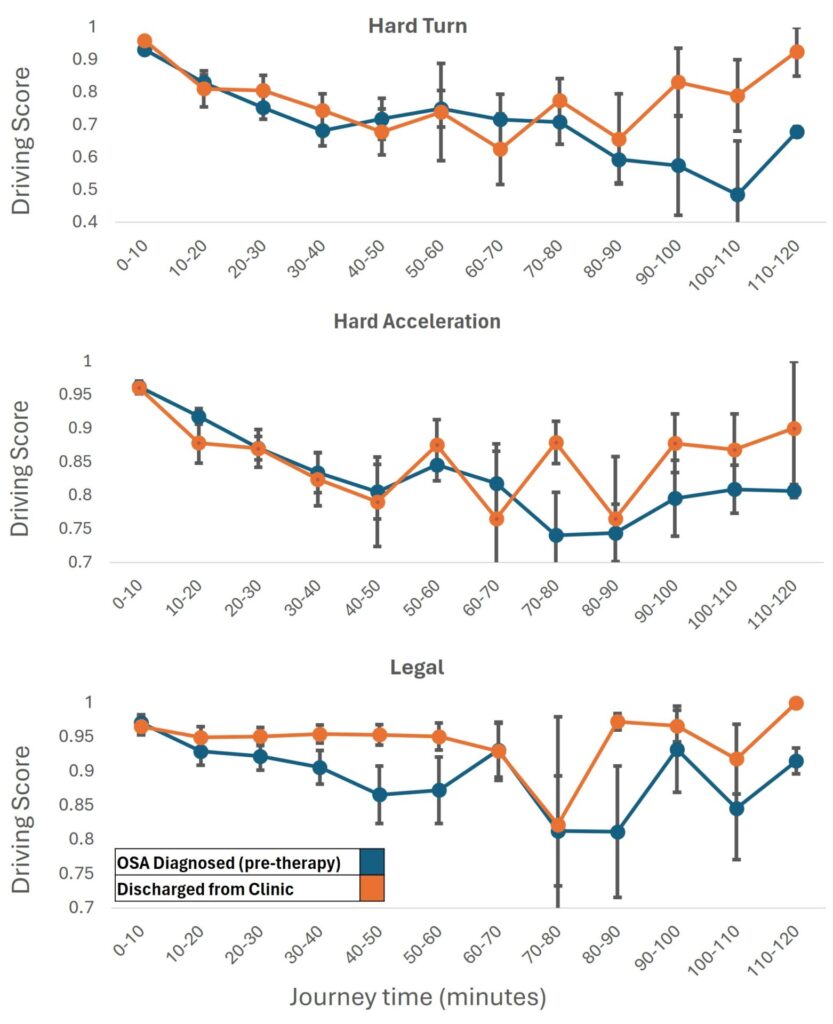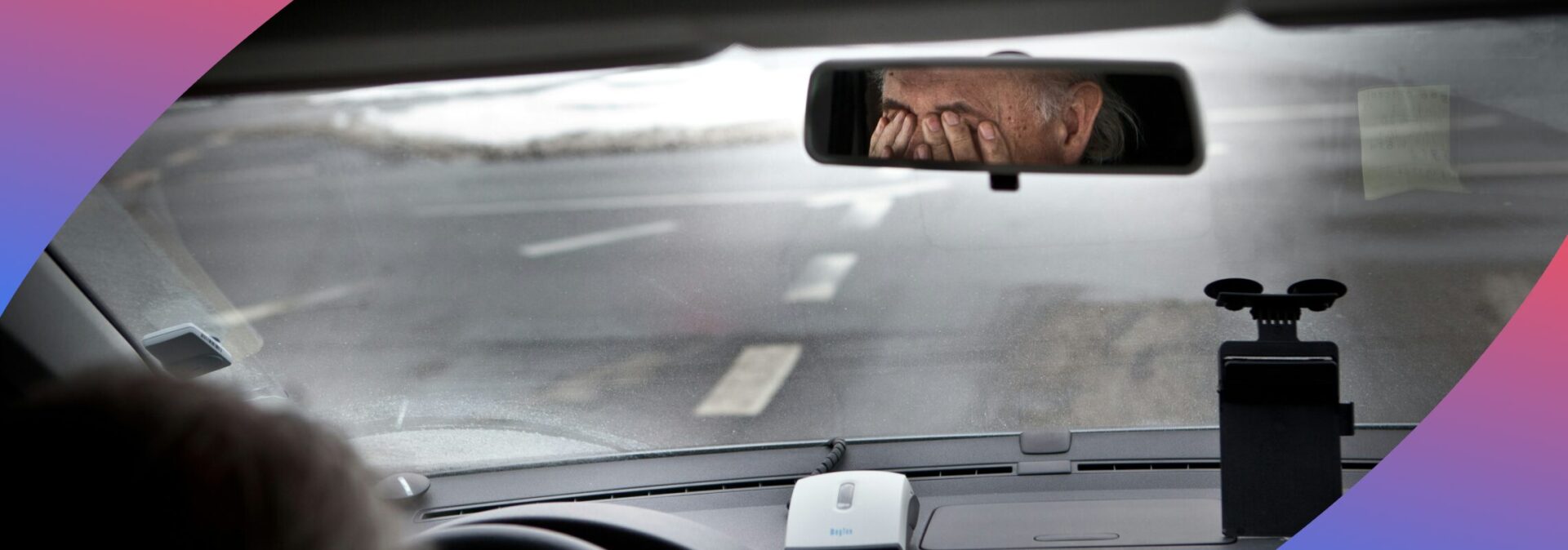Introduction
The University of Cambridge's Consciousness and Cognition Lab, in partnership with the Royal Papworth Hospital NHS Foundation Trust (RPH) and supported by Sentiance, is leading a pioneering initiative to address the critical issue of at-risk driving in patients with Obstructive Sleep Apnoea (OSA). This unique collaboration, under the banner of the ODESA study, aligns seamlessly with Sentiance’s mission to save lives every day by delivering rich, actionable driving insights.
By leveraging advanced mobile telematics data and real-world driving behaviour analysis, this partnership aims to enhance road safety, provide personalised interventions, and ultimately reduce the risk of motor vehicle accidents associated with OSA—a mission central to the efforts of all involved in making a tangible difference in people’s lives.
Understanding the impact of OSA on driving behaviour
Through collaboration between organisations holding expertise in driving behaviour insights, brain and cognitive functioning and sleep medicine, Sentiance, the C&C Lab and RPH are able to deliver a first-of-its-kind research study aimed at better understanding how driving behaviour is affected by medically diagnosed Excessive Daytime Sleepiness. Specifically, we are investigating patients being referred to RPH’s Sleep Centre with suspected OSA, a sleep related breathing disorder where the upper airways become restricted during the night, leading to sleep fragmentation, tiredness, and an increased risk of being involved in a motor vehicle accident by approximately 3x (Ellen et al, 2006). This is highly alarming considering that OSA has been estimated to affect around 1 billion people worldwide (Benjafeld et al, 2019), with many people remaining undiagnosed and untreated, particularly in areas of high deprivation (Andrienko et al, 2021).
Existing evidence and research gaps
Prior research from crash report statistics, A&E attendance, and driving simulator studies have produced strong evidence that patients with OSA are at a heightened risk of a collision. However, this risk is mitigated once a patient is compliant with CPAP (continuous positive airway pressure) therapy (Tregear et al, 2010). Despite these findings, there has not been a study directly measuring real-world driving performance in this population, leaving many uncertainties about the level of risk.
Particularly important is that it is not currently known if everyone with OSA is affected similarly or if there are factors that may make individuals either particularly resilient or susceptible to driving performance decline. Moreover, there is a lack of understanding of how well individuals can accurately assess their levels of wakefulness and determine when a break from driving is required (Anderson et al, 2023). This incomplete understanding makes it difficult for medical professionals to advise patients on driving fitness, with current guidelines placing a large amount of responsibility on patients’ subjective assessments.
Progress of the ODESA study
ODESA received full ethical approval from the British Health Research Authority in May 2023 and went live the following August. Now, one year into recruitment, 98 patients attending RPH’s Sleep Centre have volunteered to take part in the trial. Each of these participants have used the Sentiance Driving Insights App (iOS - Android), which passively collects data directly from a mobile phone’s internal sensors and translates the information into driving scores (per drive) with timestamped events. Data from 18,000 drives (6,000+ hours) has been collected thus far, which will enable a highly powered investigation into OSA-affected driving. In addition to telematic data, which is being matched with medical test results, the ODESA research group is collecting subjective experience data through Temporal Experience Traces (TET), a method developed by the C&C Lab and Human Experience Dynamics, and brain functioning data from portable electroencephalography (EEG) devices (Beacon Biosignals).
These traces allow participants to record how their experience (across domains such as wakefulness and mind-wandering) fluctuates over the course of a drive, while portable EEG recordings (used both during the night and while driving) give an indication of sleep quality and physiological alertness when on task. Together, these measurements provide a rich dataset, allowing a holistic assessment of the excess driving risk in this patient population.

Preliminary findings
Preliminary results of the study have shown clear differences in driving behaviour between individuals in our patient cohort. However, when assessed individually, these do not appear to be related to classical medical measures of OSA severity, clinical outcomes, or subjective sleepiness (as measured by routine clinical questionnaire). This finding reinforces the belief that current clinical assessments of driving fitness should be greatly improved.
A further exploratory dive into the data shows that patients ultimately diagnosed with OSA and prescribed CPAP therapy perform worse (pre-therapy) on longer drives. Moreover, subjective assessments of performance evaluation and wakefulness using TETs correlate with objective driving performance measures.
The early findings are interim at present and will be rigorously tested with robust multi-factorial analysis as the study progresses. However, our findings, even at this stage, are beginning to reveal some of the properties of the excess driving risk in this patient group.

Future potential and implications
The rich dataset emerging from the ODESA study is a first of its kind and will allow direct testing of some of the most important grey areas of OSA-affected driving. The results will lead to a better understanding of who is impaired and when at-risk driving behaviour may occur, which is the first step toward building effective interventions.
One possible mechanism for direct intervention, which appears promising, is using telematic driving data to deliver personalised recommendations. Drivers can receive highly specific feedback on their own performance, and simultaneously, medical professionals can review this information in the context of patients’ medical circumstances to provide better advice. Beyond the clinic, the ODESA research group believes this approach also has great potential to be used more broadly to help the 30-50% of the general public who suffer from daytime sleepiness (Marin 2010), by flagging when driving behaviours change.
Finally, going a step further, there is an opportunity to use this approach to completely reshape the way suspected OSA is identified and care is delivered. By using precise real-world data and a good reference, we can envision a scenario of a large-scale screening program where general road users and current patients under care for OSA are remotely monitored. When a patient’s data shows a trend toward the profile of a sleepy or OSA-affected driver over time, the individual is advised to consult a doctor for a screening test or treatment review. This would partially re-organise care resources in a structured, data-driven way to identify those displaying symptoms and who may be most at risk, in a quicker more cost-effective manner.
Conclusion
As the ODESA study continues to unfold, it promises to reshape our understanding of OSA and driving risk, paving the way for innovative approaches to patient care and road safety. The study is set to conclude enrolment by the end of 2024, with final results expected in spring 2025.
Kieran Lee
PhD Student
Consciousness and Cognition Lab
The University of Cambridge
References
Anderson, C., Cai, A. W. T., Lee, M. L., Horrey, W. J., Liang, Y., O’Brien, C. S., Czeisler, C. A., & Howard, M. E. (2023). Feeling sleepy? stop driving—awareness of fall asleep crashes. Sleep, 46(11). https://doi.org/10.1093/sleep/zsad136
Andrienko, G., Andrienko, N., Kureshi, I., Lee, K., Smith, I., & Staykova, T. (2021). Automating and utilizing equal-distribution data classification. http://openaccess.city.ac.uk/
Benjafield, A. V., Ayas, N. T., Eastwood, P. R., Heinzer, R., Ip, M. S. M., Morrell, M. J., Nunez, C. M., Patel, S. R., Penzel, T., Pépin, J. L. D., Peppard, P. E., Sinha, S., Tufik, S., Valentine, K., & Malhotra, A. (2019). Estimation of the global prevalence and burden of obstructive sleep apnoea: a literature-based analysis. The Lancet Respiratory Medicine, 7(8), 687–698. https://doi.org/10.1016/S2213-2600(19)30198-5
Ellen, R., Marshall, S., Palayew, M., Molnar, F., Wilson, K., & Man-Son-Hing, M. (2006). Systematic review of motor vehicle crash risk in persons with sleep apnea. Journal of Clinical Sleep Medicine, 2(2), 193–200. https://www.researchgate.net/publication/6280383
Marin, J. M. (2010). Obstructive Sleep Apnea: Clinical Features, Diagnosis, and Treatment.
Tregear, S. et al. (2010). Continuous Positive Airway Pressure Reduces Risk of Motor Vehicle Crash among Drivers with Obstructive Sleep Apnea: Systematic Review and Meta-analysis.


